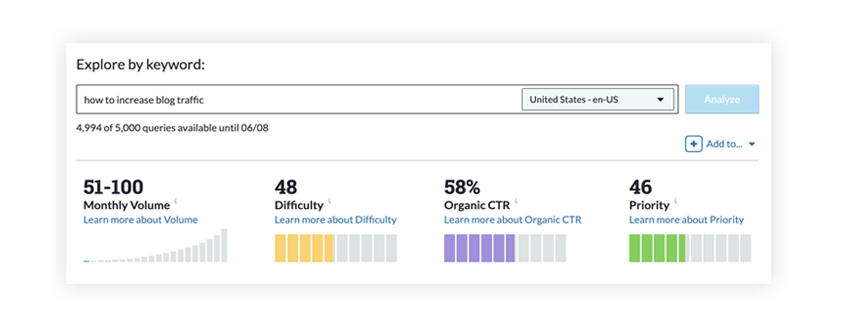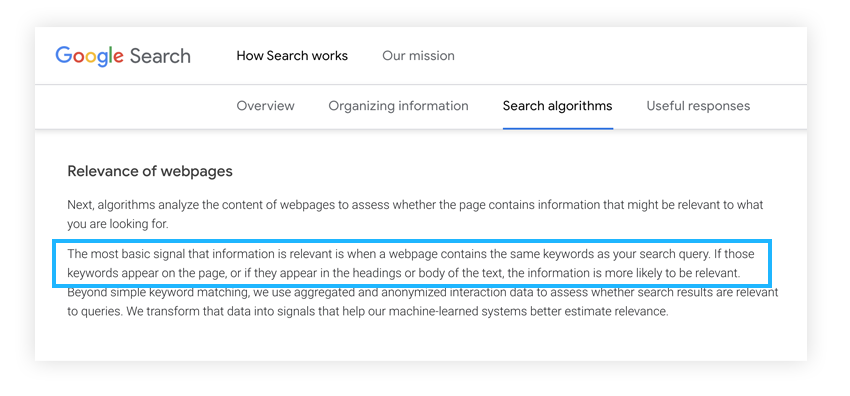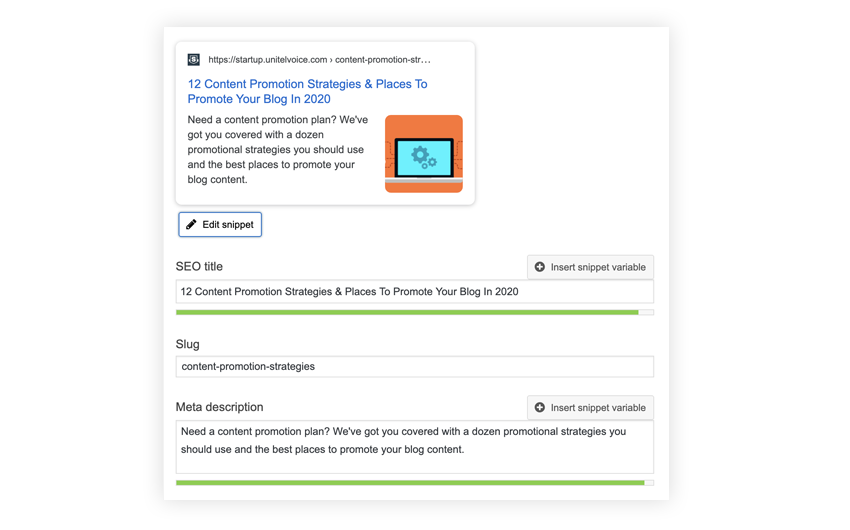
What if there was something you could do that would significantly increase your blog traffic? Something straightforward and repeatable that you could do for all the articles you post. You’d do it, right? Well, there are some simple tactics that accomplish this that most blogs ignore.
I know, because our blog used to be one of them. For the longest time, we left untold amounts of traffic on the table until finally realizing SEO (done right) matters. In this post, I’ll share the SEO checklist we’ve refined into a standard procedure that has tripled our traffic over the last few years. I'll break down each SEO tactic on our list, go over what we’ve learned, and show you how to use them to drive traffic to your own blog.
Let’s get started.
1. Precise Keyword Targeting
The first thing we do after we’ve come up with a great content idea is to identify relevant keywords. These are the words and phrases our target audience is typing into Google to find information on the subject we’re writing about.
The trick is to find relevant keywords that:
- Get high search volume
- Have low to medium difficulty
- Don’t cannibalize other content
There are a lot of inexpensive SEO tools you can use to find keywords that meet these criteria. We use Moz.

Moz tells us how many times each relevant keyword is searched per month (i.e., search volume), and how hard it would be to rank for a given keyword based on the quality of the competitor content already ranking (i.e., keyword difficulty).
Moz also tells us what keywords our blog is currently ranking for so we don’t create blog content that competes against itself on Google’s search engine results pages (or SERPs).
You want your blog post to complement your previous content, not cannibalize it.
2. Searcher Satisfaction
After we’ve identified the precise keywords we want to target, we take a stab at writing the first draft. We ask ourselves the following question:
What problem is my intended audience trying to solve? Or put another way, what task are searchers trying to accomplish when they search for my targeted keywords?
If our blog post doesn’t solve that problem or accomplish that task, then we rewrite it. By doing this we know we’re optimizing for Google’s most important ranking signal: searcher satisfaction.
What is searcher satisfaction?
Remember, Google has one goal and one goal only. It wants to give people the best results possible. And the degree to which these results give people exactly what they’re looking for when they are looking for it is called “searcher satisfaction”. The more useful your blog post is, the higher the searcher satisfaction it will have.
So, if you want your post to climb to the top of Google’s SERPs:
Write an insanely useful article.
3. Basic On-Page SEO
Once we’re confident our content is optimized for human visitors (i.e., searcher satisfaction), we make sure it’s optimized for search engines (i.e., on-page SEO). This basically means making sure our targeted keywords are in our title tags, content, internal links, and URLs.
I know what you’re thinking:
“On-page SEO? That sounds like old school stuff.”
And it is, but it’s still important today. Google’s own explanation of how search algorithms work states:

Even though Google’s algorithms are much more sophisticated than they were in the past, looking for specific keywords on your page is still a major part of their process.
You want to make sure your keywords are on your post in the following places:
- URL (keep it short)
- Page title tag (71 characters or less)
- Meta description (160 characters or less)
- H1 title tag (the title of your blog post)
- Image alt text & filename (keep it relevant)
- Body content (don’t overdo it)
- Internal links (relevant links from other posts on your blog)
4. Snippet CTR Optimization
Snippet optimization is part of on-page SEO, but it’s so important we have it listed as its own checklist item. First, let’s break down these two terms: snippet and CTR.
What is a snippet?
A snippet is the text you see for a single search result within a set of search results. It generally consists of a title, a URL, and a page description.
Here’s an example of three snippets I got when searching Google for “12 content promotion strategies”:
.png?width=900&name=4-results%20(1).png)
As you can see, snippets are the first impression of your post users see in Google’s SERPs. They’re just like an advertisement. And just like you would do for your ads, you need to optimize their click-through rate (or CTR).
What is snippet CTR?
Snippet click-through rate (also referred to as snippet CTR or “organic CTR”) is the percentage of searchers who click on a search engine result.
Why is it important to optimize? Two reasons:
First, the higher click-through rate your snippet has, the more traffic you’re going to get. If nobody clicks, nobody visits your blog.
Second, snippet CTR is one of Google’s key ranking signals. Think about it; it’s the first user experience test your blog post gets.
Now, let’s cover how we optimize our snippet CTR. To make it easy, we use a tool called Yoast.

As you can see in the screenshot above, Yoast allows us to preview what our blog post’s snippet will look like in Google’s search results.
Yoast has a mobile and desktop view showing us the exact elements we need to optimize:
- URL (slug)
- Page title tag (SEO title)
- Meta description
Here are the guidelines we use to optimize those elements:
- Keep the URL short and relevant to the primary keyword.
- Use an attention-grabbing title that incorporates the primary keywords.
- Craft a meta description using the same Q/A the searcher has in mind.
That last guideline relates to search satisfaction. It’s telling you to ask the same question your target audience is asking Google and let them know your post has the answer. That’s why it’s incredibly important that your snippet doesn’t falsely advertise.
If your snippet promises an answer your blog post doesn’t deliver, your readers are going to bounce off your blog. And when that happens, you’ll disappear from Google.
Let’s say it again.
Google has one goal and one goal only. It wants to give people the best results possible. So that’s what you have to optimize for the user, first and foremost.
5. Content Promotion
Now we’re at the part where we hit publish and our blog post goes live. But we’re not done. The final step in our SEO checklist is to promote the post. Get some eyeballs on our article and encourage Google to crawl it.
Full disclosure? This is an area where we fall short.
There are a lot of great content promotion strategies you can execute, but they take major hustle. And sometimes, we just don’t have the time to put in the effort we wish we could for every post we publish.
With that said, there are a few promotion tactics we try to do every time because we’ve found they give us the biggest bang for our buck.
Let’s start with the three primary tools we use:
- Mailchimp
- Quora
Here’s how we use each one of them:
We use Mailchimp to email our opted-in list of subscribers. We like Mailchimp because it allows us to use email automation to send and resend our content with different messaging based on engagement triggers.
But it’s important to note that we’re careful with this list. It’s taken us years to cultivate it and it’s something we try to never abuse.
The second group we email our post to is any person or company we’ve mentioned in the article. We let them know we’ve featured their work and that we’re a big fan of what they do. We do the same thing on Twitter; we DM people and tag them when we tweet.
This tactic is called “ego-baiting.”
It’s a classic inbound marketing technique where you basically stroke an influencer’s ego by featuring their product or accomplishments in your post. The hope is that your gesture will lead to that influencer reciprocating by sharing your content with their own audience or even linking to it down the road.
Word of warning: this won’t work if your article is garbage.
Your post has to add value. In fact, if it doesn’t, your ego-baiting attempt will backfire and you’ll destroy any chance of ever having a mutually beneficial relationship. Remember, strive for insanely useful content.
The final promotional tactic we use is to find someone asking questions about our article’s topic on Quora, then use our post to answer those questions.
The key is to respond to questions thoughtfully. Never just repost your article. Write something genuinely helpful that addresses people’s pain points, then mention your post.
How to Apply This to Your Business
It all starts with understanding the challenges your different customer segments face and creating the kind of content they’ll find useful. No amount of SEO will save your post if it doesn't actually solve people’s problems.
But without an effective and repeatable process for SEO, all the hard work creating great content could go to waste. Don’t make the same mistake we did early on by ignoring it.
Here's our actual Blog Post SEO Checklist (Google doc). Take it, read it, share it, print it, make your own. I hope it helps you like it has us.





Leave a reply or comment below